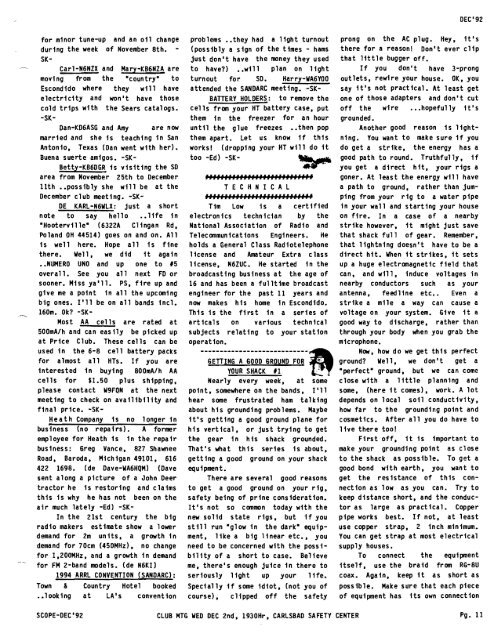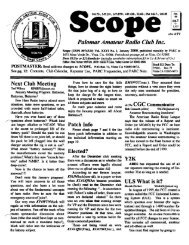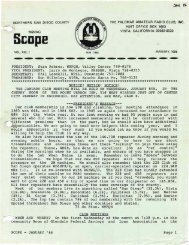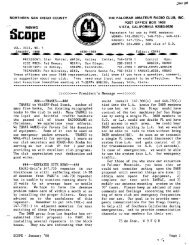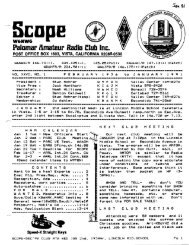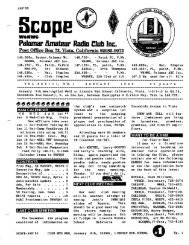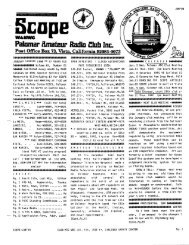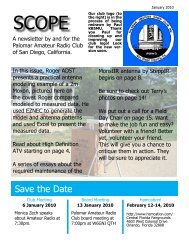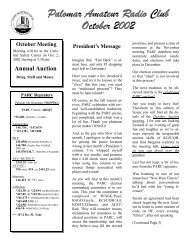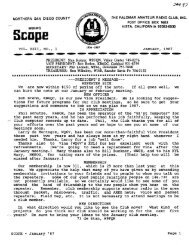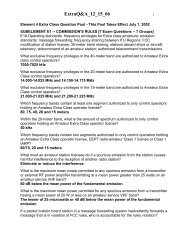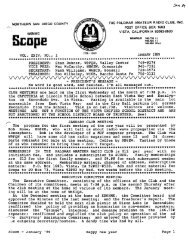1992 - Palomar Amateur Radio Club
1992 - Palomar Amateur Radio Club
1992 - Palomar Amateur Radio Club
You also want an ePaper? Increase the reach of your titles
YUMPU automatically turns print PDFs into web optimized ePapers that Google loves.
for minor tune-up and an 011 change<br />
during the week of November 8th. <br />
SIC<br />
Car1-N6NZX and Mary-ICB6NZA are<br />
moving from the ·country- to<br />
Escondido where they will have<br />
electricity and won't have those<br />
cold trips with the Sears catalogs.<br />
-SIC<br />
Dan-ICD6ASG and Amy are now<br />
married and she is teaching in San<br />
Antonio. Texas (Dan went with her).<br />
Buena suerte amigos. -SIC<br />
Betty-ICB6DGR is visiting the SO<br />
area from November 25th to December<br />
11th •• possib1y she will be at the<br />
December club meeting. -SIC<br />
DE ICARL-N6WLX: just a short<br />
note to say hello •• 1ife in<br />
·Hootervi11e· (6322A Clingan Rd.<br />
Poland OH 44514) goes on and on. All<br />
is well here. Hope all is fine<br />
there. Well. we did it again<br />
•• NOHERO UNO and up one to 15<br />
overall. See you all next FD or<br />
sooner. Miss ya'll. PS, fire up and<br />
give me a point in all the upcoming<br />
big ones. I'll be on all bands incl.<br />
160m. Ok? -SIC-<br />
Most AA cells are rated at<br />
500mA/h and can easily be picked up<br />
at Price <strong>Club</strong>. These cells can be<br />
used in the 6-8 cell battery packs<br />
for almost all HTs. If you are<br />
interested in buying 800mA/h AA<br />
cells for $1.50 plus shipping.<br />
please contact W9FQN at the next<br />
meeting to check on avai1ibi1ity and<br />
final price. -SIC-<br />
Heath Company is no longer in<br />
business (no repairs), A former<br />
employee for Heath is in the repair<br />
business: Greg Vance. 827 Shawnee<br />
Road. Baroda. Michigan 49101. 616<br />
422 1698. (de Dave-WA6HQM) (Dave<br />
sent along a picture of a John Deer<br />
tractor he is restoring and claims<br />
this is why he has not been on the<br />
air much lately -Ed) -SIC-<br />
In the 21st century the big<br />
radio makers estimate show a lower<br />
demand for 2m units. a growth in<br />
demand for 70cm (45DMHz). no change<br />
for 1.200MHz. and a growth in demand<br />
for FM 2-band models. (de N6ICI)<br />
1994 ARRL CONVENTION (SANDARC):<br />
Town & Country Hotel booked<br />
•• looking at LA's convention<br />
problems •• they had a light turnout<br />
(possibly a sign of the times - hams<br />
just don't have the money they used<br />
to have?) ••wi11 plan on light<br />
turnout for SO. Harry-WA6YOO<br />
attended the SANDARC meeting. -SIC<br />
BATTERY HOLDERS: to remove the<br />
cells from your HT battery case, put<br />
them in the freezer for an hour<br />
until the glue freezes •• then pop<br />
them apart. Let us know if this<br />
works! (dropping your HT will do it<br />
too -Ed) -SIC- ,~<br />
"",",""""""""""<br />
T E C H N I CAL<br />
.. .<br />
"""""""""""""" <br />
Tim Low is a certified<br />
electronics technician by the<br />
National Association of <strong>Radio</strong> and<br />
Telecommunications Engineers. He<br />
holds a General Class <strong>Radio</strong>telephone<br />
license and <strong>Amateur</strong> Extra class<br />
license. N6ZUC. He started in the<br />
broadcasting business at the age of<br />
16 and has been a ful1time broadcast<br />
engineer for the past 11 years and<br />
now makes his home in Escondido.<br />
This is the first in a series of<br />
artica1s on various technical<br />
subjects relating to your station<br />
operation.<br />
--;;~;;~-;-~~~~-~;~~;~-;~;-~<br />
YOUR SHACIC 11 1!l<br />
Nearly every week. at some<br />
pOint. somewhere on the bands. I'll<br />
hear some frustrated ham talking<br />
about his grounding problems. Maybe<br />
it's getting a good ground plane for<br />
his vertical. or just trying to get<br />
the gear in his shack grounded.<br />
That's what this series is about.<br />
getting a good ground on your shack<br />
equipment.<br />
There are several good reasons<br />
to get a good ground on your rig.<br />
safety being of prine consideration.<br />
It's not so common today with the<br />
new solid state rigs. but if you<br />
still run -glow in the dark- equipment.<br />
like a big linear etc •• you<br />
need to be concerned with the possibility<br />
of a short to case. Believe<br />
me. there's enough juice in there to<br />
seriously light up your life.<br />
Specially if some idiot. (not you of<br />
course). clipped off the safety<br />
DEC'92 <br />
prong on the AC plug. Hey, it's<br />
there for a reason! Don't ever clip<br />
that little bugger off.<br />
If you don't have 3-prong<br />
outlets. rewire your house. OK. you<br />
say it's not practical. At least get<br />
one of those adapters and don't cut<br />
off the wire , •• hopefully it's<br />
grounded.<br />
Another good reason is lightning.<br />
You want to make sure if you<br />
do get a strike. the energy has a<br />
good path to round. Truthfully, if<br />
you get a direct hit. your rigs a<br />
goner. At least the energy will have<br />
a path to ground. rather than jumping<br />
from your rig to a water pipe<br />
in your wall and starting your house<br />
on fire. In a case of a nearby<br />
strike however. it might just save<br />
that shack full of gear. Remember.<br />
that lightning doesn't have to be a<br />
direct hit. When it strikes. it sets<br />
up a huge electromagnetic field that<br />
can. and will. induce voltages 1n<br />
nearby conductors such as your<br />
antenna. feedline etc.. Even a<br />
strike a mile a way can cause a<br />
voltage on your system. Give it a<br />
good way to discharge. rather than<br />
through your body when you grab the<br />
microphone.<br />
Now. how do we get this perfect<br />
ground? Well. we don't get a<br />
-perfect- ground. but we can come<br />
close with a little planning and<br />
some. (here it comes). work. A lot<br />
depends on local soil conductiv1ty.<br />
how far to the grounding point and<br />
cosmetics. After all you do have to<br />
live there too!<br />
First off. it is important to<br />
make your grounding point as close<br />
to the shack as possible. To get a<br />
good bond with earth. you want to<br />
get the resistance of this connection<br />
as low as you can. Try to<br />
keep distance short. and the conductor<br />
as large as practical. Copper<br />
pipe works best. If not. at least<br />
use copper strap, 2 inch minimum.<br />
You can get strap at most electrical<br />
supply houses.<br />
To connect the eqUipment<br />
itself, use the braid from RG-8U<br />
coax. Again, keep it as short as<br />
possible. Make sure that each piece<br />
of equipment has its own connection<br />
SCOPE-DEC '92 CLUB MTG WED DEC 2nd, 1930Hr, CARLSBAD SAFETY CENTER Pg. 11


